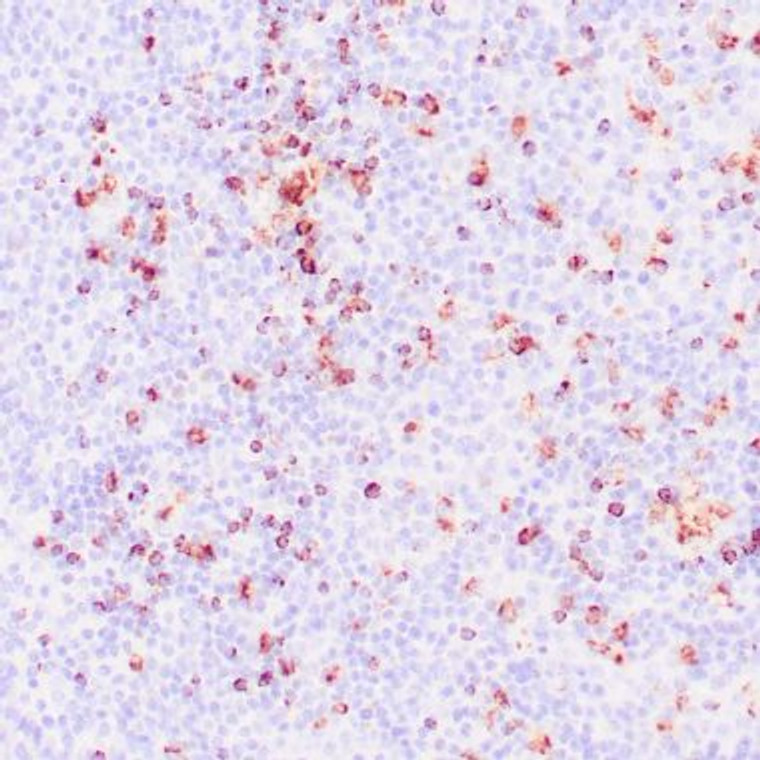| Host: |
Mouse |
| Applications: |
IHC-P |
| Reactivity: |
Human |
| Note: |
STRICTLY FOR FURTHER SCIENTIFIC RESEARCH USE ONLY (RUO). MUST NOT TO BE USED IN DIAGNOSTIC OR THERAPEUTIC APPLICATIONS. |
| Short Description: |
Mouse monoclonal antibody anti-TIA1 is suitable for use in Immunohistochemistry research applications. |
| Clonality: |
Monoclonal |
| Clone ID: |
2G9A10F5 |
| Conjugation: |
Unconjugated |
| Isotype: |
IgG1/Kappa |
| Formulation: |
Liquid in buffer with protein carrier and preservative |
| Purification: |
Affinity purified |
| Dilution Range: |
1:100 |
| Storage Instruction: |
Store at 2‐8°C for up to 24 months. Predilute: Ready to use, no reconstitution necessary. Concentrate: Use dilution range and appropriate lab‐standardized diluent. Stability after dilution: 7 days at 24°C, 3 months at 2‐8°C, 6months at ‐20°C. |
| Gene Symbol: |
TIA1 |
| Gene ID: |
7072 |
| Uniprot ID: |
TIA1_HUMAN |
| Specificity: |
Positive control: Tonsil |
| Immunogen: |
Human bone marrow malignant cells from a non-B, non-T acute leukemia |
| Tissue Specificity | Expressed in heart, small intestine, kidney, liver, lung, skeletal muscle, testes, pancreas, and ovary (at protein level). |
| Post Translational Modifications | Phosphorylated by FASTK.phosphorylation occurs after FAS ligation in FAS-mediated apoptosis and before DNA fragmentation. |
| Function | RNA-binding protein involved in the regulation of alternative pre-RNA splicing and mRNA translation by binding to uridine-rich (U-rich) RNA sequences. Binds to U-rich sequences immediately downstream from a 5' splice sites in a uridine-rich small nuclear ribonucleoprotein (U snRNP)-dependent fashion, thereby modulating alternative pre-RNA splicing. Preferably binds to the U-rich IAS1 sequence in a U1 snRNP-dependent manner.this binding is optimal if a 5' splice site is adjacent to IAS1. Activates the use of heterologous 5' splice sites.the activation depends on the intron sequence downstream from the 5' splice site, with a preference for a downstream U-rich sequence. By interacting with SNRPC/U1-C, promotes recruitment and binding of spliceosomal U1 snRNP to 5' splice sites followed by U-rich sequences, thereby facilitating atypical 5' splice site recognition by U1 snRNP. Activates splicing of alternative exons with weak 5' splice sites followed by a U-rich stretch on its own pre-mRNA and on TIAR mRNA. Acts as a modulator of alternative splicing for the apoptotic FAS receptor, thereby promoting apoptosis. Binds to the 5' splice site region of FAS intron 5 to promote accumulation of transcripts that include exon 6 at the expense of transcripts in which exon 6 is skipped, thereby leading to the transcription of a membrane-bound apoptotic FAS receptor, which promotes apoptosis. Binds to a conserved AU-rich cis element in COL2A1 intron 2 and modulates alternative splicing of COL2A1 exon 2. Also binds to the equivalent AT-rich element in COL2A1 genomic DNA, and may thereby be involved in the regulation of transcription. Binds specifically to a polypyrimidine-rich controlling element (PCE) located between the weak 5' splice site and the intronic splicing silencer of CFTR mRNA to promote exon 9 inclusion, thereby antagonizing PTB1 and its role in exon skipping of CFTR exon 9. Involved in the repression of mRNA translation by binding to AU-rich elements (AREs) located in mRNA 3' untranslated regions (3' UTRs), including target ARE-bearing mRNAs encoding TNF and PTGS2. Also participates in the cellular response to environmental stress, by acting downstream of the stress-induced phosphorylation of EIF2S1/EIF2A to promote the recruitment of untranslated mRNAs to cytoplasmic stress granules (SGs), leading to stress-induced translational arrest. Formation and recruitment to SGs is regulated by Zn(2+). Possesses nucleolytic activity against cytotoxic lymphocyte target cells. Isoform Short: Displays enhanced splicing regulatory activity compared with TIA isoform Long. |
| Protein Name | Cytotoxic Granule Associated Rna Binding Protein Tia1Nucleolysin Tia-1 Isoform P40Rna-Binding Protein Tia-1T-Cell-Restricted Intracellular Antigen-1Tia-1P40-Tia-1 |
| Database Links | Reactome: R-HSA-6803529 |
| Cellular Localisation | NucleusCytoplasmStress GranuleAccumulates In Cytoplasmic Stress Granules (Sg) Following Cellular DamageRecruitment To Sg Is Induced By Zn(2+) |
| Alternative Antibody Names | Anti-Cytotoxic Granule Associated Rna Binding Protein Tia1 antibodyAnti-Nucleolysin Tia-1 Isoform P40 antibodyAnti-Rna-Binding Protein Tia-1 antibodyAnti-T-Cell-Restricted Intracellular Antigen-1 antibodyAnti-Tia-1 antibodyAnti-P40-Tia-1 antibodyAnti-TIA1 antibody |
Information sourced from Uniprot.org
12 months for antibodies. 6 months for ELISA Kits. Please see website T&Cs for further guidance







